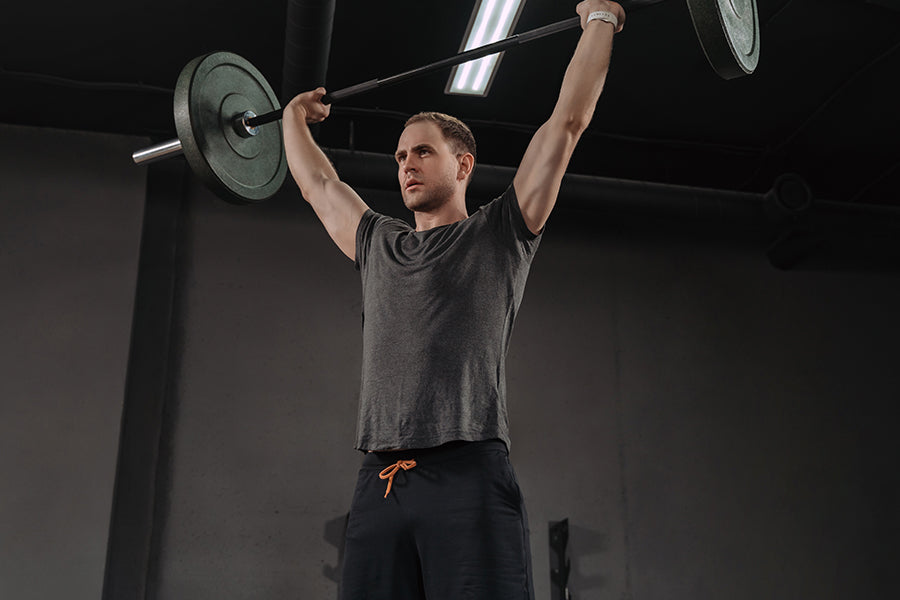Squats are one of the most effective exercises for building lower body muscles alongside improving core strength, overall health, and even upper body with a few variations.
Arnold Schwarzenegger once quoted:
"The squat is the king of all exercises. It works a large number of muscles, increases strength, builds muscle mass, and helps improve coordination and flexibility."
For this to happen, you not only have to perform a squat with proper form but also have to make sure you aren’t risking any potential injuries while doing so.
This is where squat racks play an important role.
The squat rack or a squat station is a piece of versatile and essential equipment in any strength training routine, especially in this aspect.
In this article, we will guide you through the process of safely and effectively using a squat rack, from setup to execution.
Why Choose a Squat Rack?
Since you already know what a squat rack is, the first question that comes to mind is “Do I need a squatting rack?”
To answer this question, we’ll emphasize the importance of doing squats correctly and securely once again.
Reduced Risk of Injury
A Squat Rack is needed for safety purposes in weightlifting because it provides a stable and adjustable framework to support the barbell during squats. This ensures that the lifter can safely rack and unrack the bar, reducing the risk of injury due to dropping the weight or losing control during the exercise
Full-Body Muscle Development
The squat station helps you to easily perform compound exercises that engage multiple muscle groups simultaneously.
Squats, lunges, overhead presses, and bench presses are examples of maximizing muscle and overall strength development.
Progression and Overload
Progressive overload is the key to continuous muscle and strength growth and the squat rack helps you in this regard by allowing gradual weight increases over time.
You’ll be able to do this with the help of its adjustable barbell hooks, ensuring constant challenges.
Flexibility and Versatility
Additional attachments for squatting racks like safety arms and dip bars help you to perform various exercises such as rack pulls, lunges, bench presses, and more.
This versatility targets specific muscle groups, avoids plateaus, and keeps your workouts challenging.
Solo Training
If you prefer to train solo or have a busy schedule, the squat rack is a must as it provides a safe environment for lifting heavy weights without needing a spotter.
This allows you to optimize training sessions, adjustments on the fly, and consistency even when a training partner is unavailable.
The next thing to master the art of safe squat training is to set up a Squat Rack.
How to Set Up a Squat Rack:
Setting up a squatting rack correctly ensures that you can perform exercises with optimal form, reduce the risk of injury, and maximize your training results.
We will walk you through the step-by-step process of setting up a squat rack, from choosing the right location to adjusting the squat rack parts, including safety bars or spotter arms.
Choose a Sturdy Location
Select an area with sufficient space and a solid, level floor to set up your squat rack. Ensure there are no obstacles around that may hinder your movements.
Adjust the Safety Bars
Position the safety bars or spotter arms at an appropriate height, slightly below your shoulder level. This placement ensures the bars catch the weight if you need to bail out of a squat.
Align the Barbell
Position the Barbell at chest height on the rack, ensuring it is evenly balanced. The bar of your squat rack setup should be comfortable to unrack and rack the weights without straining.
Test the Safety Bars
Before starting your workout, perform a few practice squats with lighter weights to ensure the safety bars are correctly set.
Adjust them if necessary to achieve the desired height for your range of motion.
Ways to Use a Squat Rack
While the squatting rack is commonly associated with squats, its functionality extends beyond just one exercise.
From building lower body strength to targeting the upper body and core, the squat rack provides a solid variety of exercises, some of which we are going to discuss below.
Rack Squats

A squat will be the first exercise discussed regardless of whether you prefer back squats, front squats or its other variations.
The squat rack ensures stability and safety throughout the movement, allowing you to target your quadriceps, hamstrings, glutes, and core effectively.
- To perform a racked squat, adjust the barbell hooks to a suitable height that allows you to load the barbell onto your shoulders safely.
- Position your feet slightly wider, and lower your body by bending your knees and hips at the same time.
- Keep descending until your thighs are parallel to the ground, and be sure to keep your entire movement controlled.
- Push through your heels to rise and get back to your starting position; exhale while doing so. Place the barbell on the rack once you’re done.
Related Article: 15 Common Squat Form Mistakes You Need to Avoid
Bench Press
When it comes to bench pressing, the squatting rack offers a stable platform for a safe and effective workout.
Whether you prefer a flat bench or an incline bench, the adjustable features of the rack allow you to customize the setup to your liking.
- Begin by adjusting the J-hooks to a suitable height, ensuring the barbell is just above your chest when lying on the bench; you should be at the center of the squat rack.
- Grip the bar with hands slightly wider than shoulder-width apart, maintaining a straight wrist position.
- Unrack the bar by straightening your arms, bringing it slowly above your chest with locked elbows at a 90-degree angle.
- Press the bar back up to the starting position, fully extending your arms. Once your set is complete, carefully put the bar onto those J-hooks again.
Deadlift (Rack Pull)

When it comes to deadlifting, the platform provided by the squat rack ensures a stable foundation for a safe and effective workout.
Whether you opt for traditional deadlifts or sumo deadlifts, the adjustable features of the rack empower you to customize the setup to your preference.
- Start by adjusting the hooks to the desired height, ensuring they align with the mid-shin level when standing inside.
- Grip the bar firmly with your hands and take the barbell off the hooks; keep your hands slightly wider than shoulder-width while doing so.
- Bend your hips and knees, and keep your back straight. Lift the bar by straightening your hips and knees simultaneously, ensuring the bar stays close to your body.
- Lower the bar in a controlled manner by hinging at the hips and bending your knees. After completing your deadlift squat rack set, carefully re rack the bar onto the squat rack.
Overhead Press

For overhead presses to gain strength, the squat rack provides a stable platform for a safe and effective workout.
For optimal results and proper form, adjust the barbell setup to your preferences.
- Set the squat rack's J-hooks to a height that keeps the barbell at shoulder level when standing inside the rack.
- Load the desired weight onto the barbell and grip the bar with hands slightly wider than shoulder-width apart.
- Press the barbell overhead by extending your arms. Keep your core engaged, and ensure the bar moves in a straight vertical line. Fully extend your arms at the top.
- Lower the barbell back to the starting position in a controlled manner. Once your set is complete, carefully re-rack the bar onto the J-hooks.
Accessory Exercises: Expanding Your Repertoire
The gym squat rack offers endless opportunities for incorporating accessory exercises into your routine.
You can expand your exercise repertoire by adding attachments or accessories, such as dip bars, safety arms, or weight storage pegs.
Perform exercises like dips, inverted rows, pull-ups, or even hanging leg raises using the squat rack.
This versatility allows you to target specific muscle groups, challenge yourself, and add variety to your workouts.
Related Article: Do Squats Work Calves? The Best Calf Exercises Explained
How Can You Choose the Right Squat Rack?

The right squat rack creates a safe and effective strength training environment. With many available options, finding the perfect squat rack can be daunting.
However, by considering a few key factors and understanding your specific needs, you can make an informed decision that aligns with your fitness goals.
Sturdiness and Durability
A crucial factor when selecting a squat rack is its sturdiness and durability. Look for a rack made of heavy-duty steel that can withstand heavy lifting demands.
A stable squat rack ensures safe workouts. Check customer reviews for insights on durability and performance.
Adjustability
An important consideration when choosing a squat rack is adjustability. Look for a rack with adjustable safety bars or spotter arms.
This feature allows you to adjust the height of the safety bars based on your body height and exercise routine.
Space Considerations
Before buying a squat rack in your home, measure your available space to ensure a comfortable fit in your workout area.
Choose a squat station or a squat rack with a small footprint and suitable height clearance for overhead presses. Consider a compact design or a foldable rack for easy storage.
Weight Capacity
Make sure your squat rack can handle the weight you plan to lift by checking the manufacturer's maximum weight limit.
It's recommended to choose a squat rack with a weight capacity that exceeds your current lifting capacity to allow for progression over time.
Budget
When choosing a squat rack, it's important to consider your budget, keeping in mind that a higher-quality rack may come with a higher price tag.
After considering all the important factors for selecting the best squat rack, give the DMoose Squat Rack a try to experience its durability and stability.
It is made from high-quality steel and a weighted base to ensure stability during your workouts.
Related Article: Find the Perfect Squat Rack for Your Home Gym Without Breaking the Bank
Additional Features
When choosing a squat rack, consider extra squat rack parts like pull-up bars, weight plate storage, or cable attachments.
These can expand the range of exercises you can perform and add variety to your workouts.
Takeaway
A squat rack can be a valuable addition to any home gym. It is versatile and effective in targeting multiple muscle groups and essential for ensuring your safety during workouts.
Squats and other exercises that can be performed on a squat rack are incredibly valuable for building strength and improving overall fitness.
However, they can also be dangerous if not performed correctly or with proper equipment.
A squat rack provides stability and support while lifting heavy weights, minimizing the risk of injury and allowing you to focus on your form and technique.
By investing in a high-quality squat rack, you can confidently push yourself to achieve your fitness goals without sacrificing your safety in the process.
Therefore, prioritize safety when choosing your equipment and take your fitness journey to the next level with a trusted brand that values your well-being.










